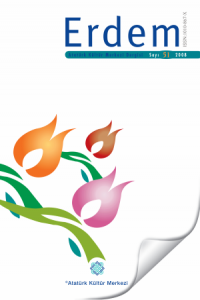Abstract
In the Ottoman Empire, Turkish women were generally introverted, devoted to their home, mostly deprived of education and they were not
economically independent. They were required to veil.
Women, even if they were not in sufficient numbers, started to attend
modern schools, established after the second half of the 19th century.
Even though women could not become members of political associations, they could undertake duties in social associations in the 19th
century. The Harem life has always aroused foreigners’ interest. The
Harem was a separate part of an Ottoman house where wives, concubines and children of the head of the family live. Sisters and daughters
of the Sultan used to have a freer life.
Women started to go out more freely in the second half of the nineteenth century. That the non-Muslim women could freely go out and
that they wore in their wish used to be tolerated.
References
- Ahmet Cevdet Paşa (1960) Tezakir (Hazırlayan: Cavit Baysun), Ankara, Türk Tarih Kurumu.
- Aksoy, Yaşar (1986)”, Bir Kent, Bir İnsan”, İstanbul.
- Amicis, Edmondo de (1986), ”İstanbul”, (Çeviren: Beynun Akyavaş), Kültür Bakanlığı.
- And, Metin (1999), “Sanatçı Cariyeler” İstanbul, Sanat Dünyamız, sayı 73.
- Avcı, Cemal (1990), “Atatürk’ün Laiklik Anlayışı”, ATAM, sayı 18.
- Beyru, Rauf (2000), 19 .Yüzyılda İzmir’de Yaşam, İstanbul.
- Çalışlar, İpek (2006), Latife Hanım, İstanbul.
- D’ Ohsson (sene yok), 18. Yüzyıl Türkiye’sinde Örf ve Adetler (Çeviren: Zerhan Yüksel), İstanbul, Tercüman 1001 Temel Eser.
- Heppner, Harold (1987) ”Aydınlanma Çağında Batılıların Türk İmajı” Eskişehir, I. Uluslar arası Seyahat-nâmelerde Türk ve Batı İmajı Sempozyumu Bildirileri.
- Karal, Enver Ziya (1962), Osmanlı Tarihi, c. VIII, Ankara, Türk tarih Kurumu Yayını.
- Karal, Enver Ziya (1946), III. Selim’in Hatt-ı Hümâyûnları, Ankara, Türk Tarih Kurumu.
- Koç, Bekir (1996), II. Mahmut’un Hatt-ı Hümâyûnları, Ankara, Basılmamış Doktora Tezi, Ankara Üniversitesi Sosyal Bilimler Enstitüsü.
- Montague, Mary Wortley (1933), Şark Mektupları, (Çeviren: A. Refik Altınay), İstanbul.
- Montagu, Mary Wortley (sene yok): Türkiye Mektupları, (Çeviren: Aysel Kurutluoğlu), İstanbul, Tercüman 1001 Temel Eser.
- Neava, Danin L. (1978), Eski İstanbul Hayatı, İstanbul, Tercüman 1001 Temel Eser.
- Özkaya, Yücel (1990), “III. Selim’in İmparatorluk Hakkındaki Bazı Hatt-ı Hümâyûnları”, Ankara, OTAM, c.1, sayı 1.
- Raczynski, Edward, 1814’te İstanbul ve Çanakkale’ye Seyahat, (Çeviren: Kemal Turan), İstanbul, Tercüman 1001 Temel Eser.
- Ricault, Türklerin Siyasî Düstûrları, (Çeviren M. Reşat Uzmen), İstanbul, Tercüman 1001 Temel Eser.
- Sefa, Peyami (1988), Türk İnkılâbına Bakışlar, Ankara, Atatürk Araştırma Merkezi.
- Schiffer, Rheinhold (1987), “19 Yüzyıl Seyahat-nâmelerinde Türk Kadını ve Türk Erkeği İmajı, Eskişehir, I. Uluslar arası Seyahat-nâmelerde Türk ve Batı İmajı Sempozyumu”.
- Serrana, Manuel y. Sanz, Türkiye’nin Dört Yılı, (Çeviren: Aysel Kurutluoğlu), İstanbul, Tercüman 1001 Temel Eser.
- Şemşettin Sami (1996), Kadınlar, (Hazırlayan: İsmail Doğan), Ankara
- Tott, Francoıs de (Baron), Teşrifat ve Teşkilâtımız, (Hazırlayan: Ahmet Banoğlu), Tercüman 1001 Temel Eser.
- Uluçay, Çağatay (1985), Harem, II, İstanbul, Türk Tarih Kurumu.
- Us, Hakkı Tarık (1939), Meclis-i Mebusan, İstanbul, c. 1.
Abstract
Osmanlı İmparatorluğu’nda Türk kadınları daha çok içine kapanık, ekonomik özgürlüğü olmayan, evine bağlı, genellikle eğitimden yoksun
idiler.
XIX. yüzyılın ikinci yarısından itibaren açılan okullara az sayıda
olsa da girmişlerdir.
XIX. yüzyılda siyâsî derneklerde olmamalarına karşın, sosyal derneklerde görev almışlardır.
Harem hayatı her zaman yabancıların ilgisini çekmiştir.
Harem, ev reisinin kadınlarının, cariyelerinin ve çocuklarının yaşadığı yer olup, aynı
zamanda evin kadını anlamına gelmekte idi.
Padişahın kız kardeşleri ya da kızları serbest bir hayat sürerlerdi.
XIX. yüzyılın ikinci yarısında kadınların dışarıda serbestçe dolaşması
artmıştır. Müslümanların dışındaki kadınların serbestçe dolaşması ve
giyinmesi hoş görüyle karşılanmaktaydı.
References
- Ahmet Cevdet Paşa (1960) Tezakir (Hazırlayan: Cavit Baysun), Ankara, Türk Tarih Kurumu.
- Aksoy, Yaşar (1986)”, Bir Kent, Bir İnsan”, İstanbul.
- Amicis, Edmondo de (1986), ”İstanbul”, (Çeviren: Beynun Akyavaş), Kültür Bakanlığı.
- And, Metin (1999), “Sanatçı Cariyeler” İstanbul, Sanat Dünyamız, sayı 73.
- Avcı, Cemal (1990), “Atatürk’ün Laiklik Anlayışı”, ATAM, sayı 18.
- Beyru, Rauf (2000), 19 .Yüzyılda İzmir’de Yaşam, İstanbul.
- Çalışlar, İpek (2006), Latife Hanım, İstanbul.
- D’ Ohsson (sene yok), 18. Yüzyıl Türkiye’sinde Örf ve Adetler (Çeviren: Zerhan Yüksel), İstanbul, Tercüman 1001 Temel Eser.
- Heppner, Harold (1987) ”Aydınlanma Çağında Batılıların Türk İmajı” Eskişehir, I. Uluslar arası Seyahat-nâmelerde Türk ve Batı İmajı Sempozyumu Bildirileri.
- Karal, Enver Ziya (1962), Osmanlı Tarihi, c. VIII, Ankara, Türk tarih Kurumu Yayını.
- Karal, Enver Ziya (1946), III. Selim’in Hatt-ı Hümâyûnları, Ankara, Türk Tarih Kurumu.
- Koç, Bekir (1996), II. Mahmut’un Hatt-ı Hümâyûnları, Ankara, Basılmamış Doktora Tezi, Ankara Üniversitesi Sosyal Bilimler Enstitüsü.
- Montague, Mary Wortley (1933), Şark Mektupları, (Çeviren: A. Refik Altınay), İstanbul.
- Montagu, Mary Wortley (sene yok): Türkiye Mektupları, (Çeviren: Aysel Kurutluoğlu), İstanbul, Tercüman 1001 Temel Eser.
- Neava, Danin L. (1978), Eski İstanbul Hayatı, İstanbul, Tercüman 1001 Temel Eser.
- Özkaya, Yücel (1990), “III. Selim’in İmparatorluk Hakkındaki Bazı Hatt-ı Hümâyûnları”, Ankara, OTAM, c.1, sayı 1.
- Raczynski, Edward, 1814’te İstanbul ve Çanakkale’ye Seyahat, (Çeviren: Kemal Turan), İstanbul, Tercüman 1001 Temel Eser.
- Ricault, Türklerin Siyasî Düstûrları, (Çeviren M. Reşat Uzmen), İstanbul, Tercüman 1001 Temel Eser.
- Sefa, Peyami (1988), Türk İnkılâbına Bakışlar, Ankara, Atatürk Araştırma Merkezi.
- Schiffer, Rheinhold (1987), “19 Yüzyıl Seyahat-nâmelerinde Türk Kadını ve Türk Erkeği İmajı, Eskişehir, I. Uluslar arası Seyahat-nâmelerde Türk ve Batı İmajı Sempozyumu”.
- Serrana, Manuel y. Sanz, Türkiye’nin Dört Yılı, (Çeviren: Aysel Kurutluoğlu), İstanbul, Tercüman 1001 Temel Eser.
- Şemşettin Sami (1996), Kadınlar, (Hazırlayan: İsmail Doğan), Ankara
- Tott, Francoıs de (Baron), Teşrifat ve Teşkilâtımız, (Hazırlayan: Ahmet Banoğlu), Tercüman 1001 Temel Eser.
- Uluçay, Çağatay (1985), Harem, II, İstanbul, Türk Tarih Kurumu.
- Us, Hakkı Tarık (1939), Meclis-i Mebusan, İstanbul, c. 1.
Details
| Primary Language | Turkish |
|---|---|
| Journal Section | Erdem |
| Authors | |
| Publication Date | August 3, 2008 |
| Published in Issue | Year 2008 Issue: 51 |
ERDEM Journal is indexed by TR Dizin, MLA International Bibliography, EBSCOhost, SOBIAD, ASI (Advanced Science Index) ISAM, DAVET and AYK Journal Index.

